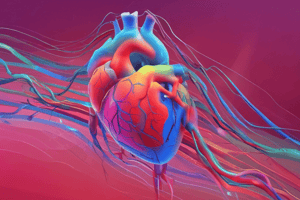Podcast
Questions and Answers
What are premature ventricular contractions (PVCs)?
What are premature ventricular contractions (PVCs)?
PVC is a contraction coming from an ectopic focus in the ventricles. It is the premature early occurrence of a QRS complex. PVCs are wide and distorted in shape.
Which of these are terms to describe a PVC? (Select all that apply)
Which of these are terms to describe a PVC? (Select all that apply)
- Wide (correct)
- Early complex (correct)
- Narrow
- Bizarre (correct)
What are unifocal PVCs?
What are unifocal PVCs?
PVCs that arise from the same ectopic foci.
What are multifocal PVCs?
What are multifocal PVCs?
What does bigeminy refer to?
What does bigeminy refer to?
What does trigeminy refer to?
What does trigeminy refer to?
What is a couplet PVC?
What is a couplet PVC?
What is a triplet PVC?
What is a triplet PVC?
What does an ECG show for PVC?
What does an ECG show for PVC?
What are some common causes of PVCs? (Select all that apply)
What are some common causes of PVCs? (Select all that apply)
What is the clinical significance of PVCs in a patient with heart disease?
What is the clinical significance of PVCs in a patient with heart disease?
What defines ventricular tachycardia (V-tach)?
What defines ventricular tachycardia (V-tach)?
What is the priority intervention for a patient with V-tach?
What is the priority intervention for a patient with V-tach?
What is the preferred treatment for stable patients with monomorphic VT?
What is the preferred treatment for stable patients with monomorphic VT?
What is the treatment for polymorphic VT with a long QT?
What is the treatment for polymorphic VT with a long QT?
What is the treatment for VT without a pulse?
What is the treatment for VT without a pulse?
What is ventricular fibrillation (V-fib)?
What is ventricular fibrillation (V-fib)?
What is the priority treatment for V-fib?
What is the priority treatment for V-fib?
What does asystole signify?
What does asystole signify?
What is Pulseless Electrical Activity (PEA)?
What is Pulseless Electrical Activity (PEA)?
What is the treatment for PEA?
What is the treatment for PEA?
What do H’s and T’s refer to?
What do H’s and T’s refer to?
Flashcards are hidden until you start studying
Study Notes
Premature Ventricular Contractions (PVCs)
- PVCs originate from an ectopic focus in the ventricles, causing early QRS complex occurrence.
- Descriptors for PVCs include early complex, wide, bizarre shape, and high amplitude.
- Unifocal PVCs arise from a single ectopic focus, presenting similarly.
- Multifocal PVCs stem from multiple ectopic foci, leading to different shapes.
Types and Patterns of PVCs
- Bigeminy indicates a PVC occurring every other beat.
- Trigeminy refers to a PVC every third beat.
- A couplet consists of two consecutive PVCs.
- A triplet consists of three consecutive PVCs, indicative of a short run of ventricular tachycardia (V-tach).
ECG Characteristics
- The ECG shows irregular rhythm with varying heart rates due to PVCs.
Etiology of PVCs
- Common stimulants include caffeine, nicotine, stress, and exercise; also linked to low potassium and magnesium, hypoxia, fever, and several heart conditions such as myocardial infarction (MI) and cardiomyopathy.
Clinical Significance of PVCs
- PVCs generally have no significance in healthy hearts.
- In patients with heart disease, PVCs can decrease cardiac output and contribute to angina or heart failure.
- In coronary artery disease (CAD) and MI, PVCs indicate ventricular irritability; assessment of patient response is critical.
Ventricular Tachycardia (V-tach)
- Defined by three or more consecutive PVCs, V-tach occurs when an ectopic focus becomes the heart's pacemaker.
- Assessment of level of consciousness (LOC) and vital signs is essential.
Types of V-tach
- Monomorphic VT features consistent shape and direction in QRS complexes.
- Polymorphic VT is characterized by changing shapes and sizes of QRS complexes.
Torsades de Pointes
- A type of polymorphic VT associated with prolonged QT intervals and low magnesium levels.
Etiology of V-tach
- Causes include myocardial infarction, coronary artery disease, electrolyte imbalances, cardiomyopathy, and drug toxicity; can occur even in patients without apparent heart disease.
V-tach Management
- Stable patients with monomorphic or polymorphic VT: treatment options include amiodarone or adenosine.
- Polymorphic VT with long QT in stable patients: magnesium, phenytoin, and pacing are treatments; discontinue QT-prolonging medications.
Emergency Interventions
- For pulsed but symptomatic VT: synchronized cardioversion is recommended.
- For pulseless VT: immediate defibrillation, CPR, and administration of epinephrine and amiodarone are necessary.
Ventricular Fibrillation (V-fib)
- V-fib is a critical disorder characterized by disorganized electrical activity in the ventricles, leading to ineffective contractions and no cardiac output; classified as a lethal rhythm.
Etiology of V-fib
- Common causes include acute MI, heart failure, electrolyte imbalances, hypoxia, acidosis, electric shock, and drug toxicity.
V-fib Management
- Priority treatment involves defibrillation, high-quality CPR, and medications like epinephrine and amiodarone.
Asystole
- Characterized by total lack of ventricular electrical activity, patients are unresponsive, pulseless, and apneic; classified as lethal and requires rhythm assessment in multiple leads.
- Management includes CPR and epinephrine.
Pulseless Electrical Activity (PEA)
- Defined by organized electrical activity on ECG without a pulse; it's the most common post-defibrillation dysrhythmia, with a poor prognosis unless the cause is promptly identified.
- Management involves CPR and epinephrine, along with assessment for underlying causes.
H's and T's
- Key reversible causes of PEA include:
- Hypovolemia
- Hypoxia/hypoxemia
- Acidosis (hydrogen ion excess)
- Electrolyte imbalances (hypo/hyperkalemia)
- Hypothermia
- Cardiac tamponade
- Toxin exposure
- Tension pneumothorax
- Thrombosis (pulmonary or coronary)
Studying That Suits You
Use AI to generate personalized quizzes and flashcards to suit your learning preferences.




